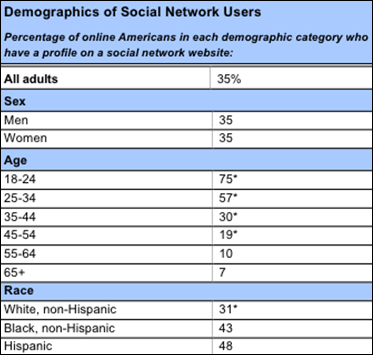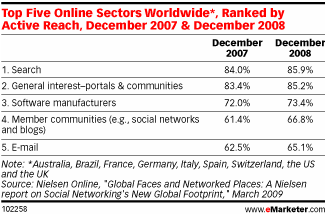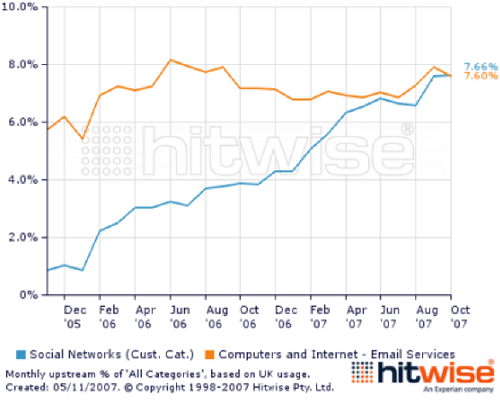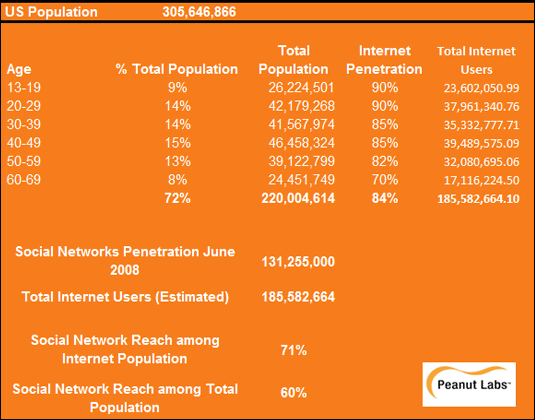 |
Murtaza Hussain
Murtaza Hussain is a co-founder and the President of Peanut Labs, leading overall strategy and product direction. Murtaza has been instrumental in forming industry changing partnerships that bridge social media and online communities with the business application needs of the market research community.
Read the full biography here. |
The Growth of Social Networking – Just the Facts...
By Murtaza Hussain - 6 October, 2009
Recent 2009 findings from the Pew Research Center say the percentage of adults who have profiles on at least one social-networking site has skyrocketed to 35 percent, up from only 8 percent in 2005.

Social networking Web sites and blogs now account for nearly ten percent of the total time spent on the internet, exceeding even email, according to a new study released by Nielsen Online.
"While two-thirds of the global online population already accesses member community sites, their vigorous adoption and the migration of time show no signs of slowing," said John Burbank, the CEO of Nielsen Online.
The Nielsen Online study also found that social networks now exceed email.

In 2007, communication via social networks exceeded email as the primary means of online communication in the UK.

How does all this compare to the overall population in the US? The chart below shows the penetration of social networks in the US as a percentage of the overall population and the Internet population.

How does this Impact Research?
First, the use of email to send survey invites is becoming increasingly difficult. The sheer numbers of email required to be sent to just fill a basic market research study is staggering due to the low response rates. Peanut Labs has developed a way to access respondents within their social network thus eliminating the need to send invites via email. You can see our process by downloading this PDF:
Bias
Bias comes in many different ways; sampling methodology, data collection process and the questionnaire itself are the main ways bias can be introduced. Online sample bias has been well documented and most users are aware of it. Online sample bias can also be created by the panel recruitment process. Clearly there will also be bias among our social network respondents since we obtain them all from social networks. As the charts above show, a rapidly growing percentage of the US population are joining social networks, but there will always be people who use social networks and those who do not. Peanut Labs sourcing is very broad and utilizes over 120 different networks and applications. We believe that our respondent bias is actually reduced from what online panels experience since our respondents did not join the social network for the sole purpose of taking surveys. While we know there is bias, we also have several significant independent research on research projects that, despite the bias, showed that data collected from respondents from social networks is no different than other sources.
Sample Consistency
By integrating with a large number of diverse social networking applications and communities (ours includes 120 plus), and not locking in to any site but staying free to follow the crowd as they migrate to the latest hot spots, it is possible to ensure broad representation. A 2009 case study completed by Ipsos and presented at CASROshowed that responses from Peanut Labs social network sample ‘are not different in a substantial way from data collected via other sources. Both data quality and survey results are comparable’ – see Ipsos Social Network Sample Research.
It's important to present surveys in the context of the network – a place respondents are comfortable – and always present multiple opportunities to earn virtual currency. This is part of the effort to keep people engaged even if they’re not eligible for a particular survey. Socially Networked Sample is different from traditional opt-in panels in three important ways.
| |
1. |
The surveys are a fun activity that consumers enjoy within the context of their trusted community. They’re not gathering for the sole purpose of a survey. Recruitment, incentives, and surveys are all promoted through the voice of their trusted network.
|
| |
2. |
You can gather data in hours, not days or weeks. Our technology integration allows instant, 24/7 access to statistically significant research, worldwide or in selected geographies. Since invitations are not emailed, we don’t have to wait for email responses.
|
| |
3. |
You get better results with relevant incentives. We reward respondents the virtual currency they want instead of a token cash payment. These payments are made in real-time with relevant virtual currency unique to the respondent’s social network. |
To see more detail about the sampling process, you can download the PDF on Socially Networked Sample here: Socially Networked Sample .

Murtaza Hussain
Comments on this article

Want to share your thoughts...?
NOTE: Please note that this board is moderated, and comments are published at the discretion of the site owner.
|